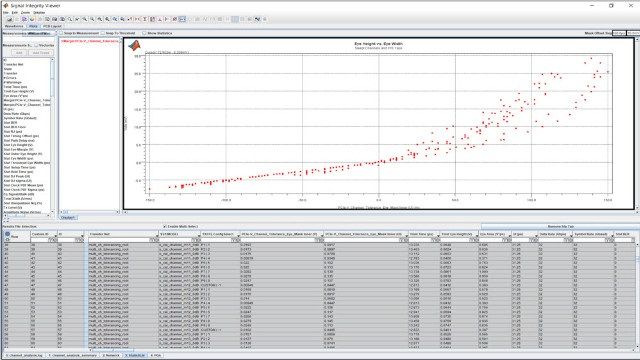SerDes Toolbox provides a MATLAB and Simulink model library and a set of analysis tools and apps for the design and verification of serializer/deserializer (SerDes) systems or high-speed memory PHYs such as DDR5. You can automatically generate dual PAMn IBIS-AMI models for statistical analysis and time-domain simulation, including PAM3 for USB4 v2 and GDDR7, PAM4 for Ethernet, OIF CEI, and PCIe, as well as PAM8 and PAM16 for automotive SerDes applications like ASA, Automotive Ethernet, and MIPI A-PHY.
With the SerDes Designer app, you can use statistical analysis to rapidly design wired communications links. The app provides parameterized models and algorithms that let you explore a wide range of equalizer configurations to improve channel performance. You can assess metrics such as eye diagram, bathtub curve, and channel operating margin (COM), including the effects of jitter and crosstalk.
With MATLAB based building blocks such as CTLE, DFE, FFE, and CDR, you can describe your chosen architecture using datasheets or measurement data and simulate control and adaptative algorithms. White-box examples of typical applications such as PCIe®, USB, Ethernet, and DDR provide reference designs that you can use as a basis for your own designs.
SerDes System Design
Using the SerDes Designer app, design, configure, and analyze SerDes systems. Create SerDes floor plans and check performance metrics such as COM, BER, bathtub curves, and other visualizations. Generate Simulink and IBIS-AMI models for further refinement and verification.
SerDes Analysis and Simulation
Using Simulink, perform statistical analysis to visualize the statistical eye diagram, pulse response, and its derived waveform and other metrics. Perform time-domain simulation of adaptive algorithms using customizable Simulink blocks.
IBIS-AMI Model Generation
Generate industry compliant IBIS-AMI statistical (Init), time-domain (GetWave), or dual algorithmic models for PAMn modulations. Customize the model by managing IBIS-AMI parameters from the SerDes Designer app and Simulink.
Adaptive Equalizer Design
Use DFE, CTLE, FFE, AGC, and CDR to design adaptive equalizers. Use parametrized blocks and algorithms for single-ended and differential signals. Explore adaptation strategies to optimize your SerDes system performance and generate IBIS-AMI models.
Industry Standard Reference Designs
Use industry standard reference designs for PCIe 6.0, LPDDR5X, OIF CEI-112G-VSR, UCIe, and more. Start with reference models and refine them to design SerDes using PAM2 through PAM16 modulation schemes to generate standard-compliant IBIS-AMI models.
SerDes Regression Testing
Use Signal Integrity Toolbox to verify the IBIS-AMI models. If an issue is identified, use Signal Integrity Link to import the parameters, stimuli, and channel back to Simulink. Use all the debug tools of MATLAB and Simulink to analyze and update the model.
SerDes Optimization
Tune and optimize SerDes performance metrics using surrogate optimization or generate IBIS-AMI models that can use genetic algorithms to improve the performance of SerDes global optimization.
Waveform Measurements
Perform jitter measurements and generate eye diagrams to evaluate measured or simulated waveform performance and ensure reliable high-speed data transmission.
Product Resources:

“The process of creating and configuring IBIS-AMI models with SerDes Toolbox is straightforward and fast to learn. After completing it once ourselves, we had full control over IBIS-AMI model creation, and eliminated our dependence on contractors.”







